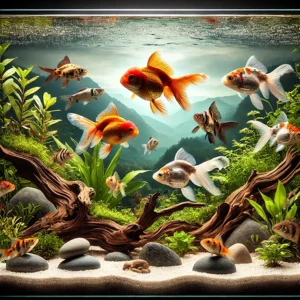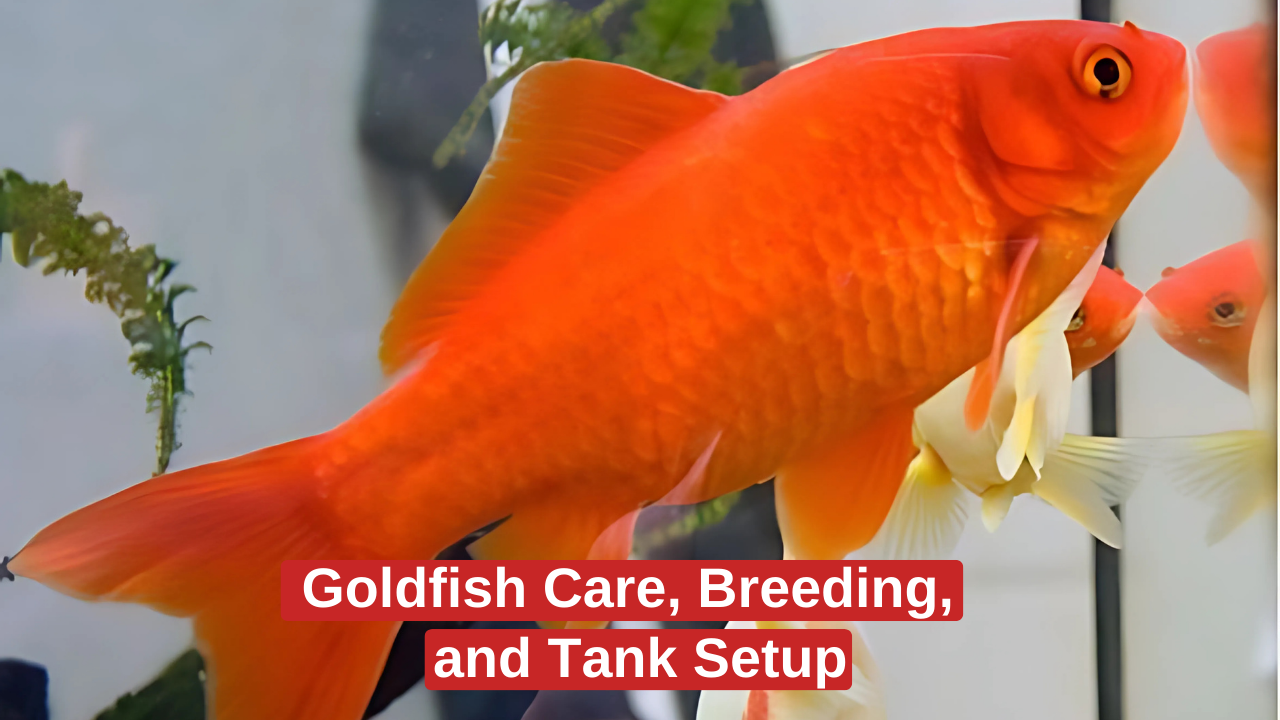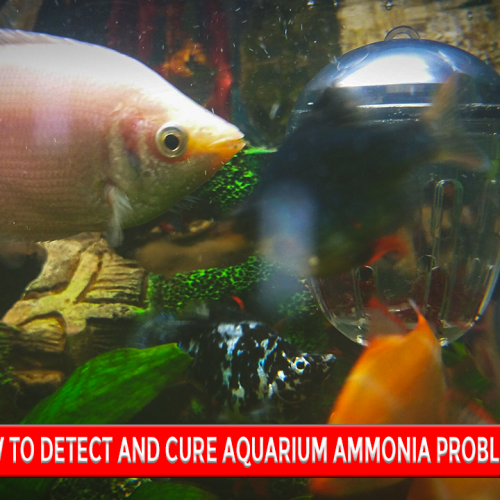Goldfish are, probably, the most popular fish all over the world in one of the largest aquatics in petting zoos, adored for their bright colours, shapes, and relatively low demands for care. Although they are this easy to keep, goldfish are not for beginners; rather, good care, proper tank setup, and knowing their history in breeding would bring them true value in the aquarium. The comprehensive guide will cover everything about goldfish care and breeding, set up in a tank, common health issues, and suitable tank mates for that purpose, the idea being to help fishkeepers provide their aquatic pets with a good environment.
Goldfish Care
Caring for goldfish is not just throwing them in the water; it consists of knowing some special needs regarding tank size, water quality, and feeding to see that they live a long healthy life. Below are what you need to know for the caring of your goldfish:
1. Tank Size and Setup
- Choosing the Right Tank Size: The most common mistake that beginners commit is keeping goldfish in a very small tank. Goldfish can grow very big; some of them may even grow up to 12 inches or more. For one goldfish, it is advisable to keep them in a minimum 20-30 gallons tank and extra 10-15 gallons for each additional fish. It allows swimming space and maintains the quality of the water.
- Tank Shape Considerations: A long, rectangular one is preferable rather than a tall, narrow one since the greater surface area and thus better oxygen transfer is permitted. Goldfish are primarily active swimmers. They need much horizontal room to move around.
- Substrate Selection: It must be made of sand or rounded gravels so the moving fins of the fish will not get hurt. Omit using sharp and jagged decorations since these may tear the fins or cause any sort of physical injury.
- Decor and Aquascaping: While goldfish enjoy a wide range of decorations and places to hide, ensure that you only use smooth rocks, driftwood, or plastic plants that are not sharp. Live plants may be included in the aquarium, but remember that goldfish like to nibble on them.
2. Filtration Requirements
- Powerful Filtration: Since they are large and undertake such large diets in their bodies, goldfish produce much waste. They consequently require the strongest filter that ensures water remains clean. Its filter, therefore, needs to both mechanically remove debris and biologically filter through helpful bacteria to break down toxic compounds.
- Water Flow Balance: While intense filtration is quite in order, it’s equally important that water flow should not be so strong, especially for fancy varieties of goldfish, which may not swim so comfortably at high currents. The best would be to keep the flow rate soft to moderate.
3. Maintaining Water Parameters
- Optimal Temperature Range: Goldfish are cold-water fish, and between 65 to 75°F (18°C to 24°C) is best for them. Besides, any variation of the given temperature outside this will easily cause undue stress to the fish, thereby affecting health.
- pH Levels: Goldfish are best kept in neutral to slightly alkaline condition. The ideal pH should be maintained at a level between 7.0 and 7.5. Testing the water every month and, if possible daily is advisable to ensure constant maintaining of this level.
- Regular Water Changes: Change 25-30% of the water every week in order to help regulate the buildup of ammonia, nitrites, and nitrates that are potent toxins. It also replenishes trace elements and keeps the environment stable.
- Dechlorination: Water conditioner is always indispensable for removal of chlorine and chloramines from tap water before use in the tank.
4. Lighting Considerations
- Moderate Lighting: Goldfish do not require strong light, but a constant day-night cycle will help them maintain their biological activities. Maintain 8-12 hours of light per day. No direct sunlight that creates regular temperature fluctuations and algae.
5. Feeding Guidelines
- Balanced Diet: Goldfish should be fed with a balanced and high-quality source of pellets or flakes as staple. Supplemental foods in the diet may be supplied fresh vegetables like peas, lettuce, or zucchini and live or frozen foods, such as brine shrimp or bloodworms, to provide a full nutritional profile.
- Feeding Frequency: Feed 2-3 times a day only up to what they are able to consume within 2-3 minutes.. Overfeeding leads to poor water quality and even health problems such as swim bladder disorders.
- Avoid Floating Foods: Feed sinking pellets or pre-soak dry foods in order to prevent gulping air at the surface that brings digestive issues to the fish.
Goldfish Breeding
Actually, breeding goldfish proves quite rewarding but very demanding in preparation and detail. Here’s how you go about successfully breeding your goldfish:
1. Setting Up the Breeding Tank
- Breeding Tank Requirements: Breed in separate breeding tank with a minimum volume of 20-30 gallons to be sure that the adult will not eat the eggs and fries. Fine-leaved plants or spawning mops, artificial brushes are where the eggs will attach themselves.
- Conditioning the Breeding Pair: Before breeding, condition the male and female goldfish by feeding them a high-protein diet of live or frozen foods (such as bloodworms and daphnia) for several weeks. This will help promote optimal health and fertility.
2. Inducing Spawning
- Temperature Manipulation: Gradually raise the water temperature in the breeding tank to 70-75°F (21-24°C). Thus, this rise will simply mimic the natural spawning season and spawn fish.
- Recognizing Spawning Behavior: after the females, the male will zip around the aquarium and will bump the vent of females to stimulate spawning, then the females will disperse and the eggs will attach to plants or spawning mops.
3. Caring for Eggs and Fry
- Protecting the Eggs: After this has been done, remove the adults from the spawning tank so they don’t eat the eggs.
- Incubation Period: The eggs incubate for 4-7 days depending on the incubation temperature.
- Feeding the Fry: Feeding the Fry Provisions of infusoria or commercially prepared fry food should be given. While growing older, crushed flakes or finely ground pellets can be introduced. The food must be of a size that is large enough for the tiny fry.
Tank Setup
The cleanliness and health of an environment, therefore, determine the well-being of a goldfish. Keeping the tank clean often saves a lot of treatments for common conditions and keeps the environment stable.
1. Regular Water Changes
- Frequency: Once a week in per cent, perform water changes of 25-30% to remove toxins and minerals that are being depleted. Change the substrate with a gravel vacuum.
- Avoid Drastic Changes: Avoid changing a large quantity of water in one period as it causes stress or shock to the fish due to sudden changes in water chemistry.
2. Filter Maintenance
- Clean Filter Media: Rinse the filter media in a bucket of tank water to avoid killing the good bacteria that will help your system go through a normal filtration cycle. Tap water should not be used since it contains chlorine, an ingredient in it which would kill the very bacteria that help keep the water clean.
- Monitor Filter Efficiency: Components of filters should be replaced or cleaned up when no longer functional.
3. Monitoring Water Quality
- Regular Testing: Testing of aquarium is regularly carried out with a good testing kit to establish ammonia, nitrite, nitrate, and pH. Once these are kept under control, stress and disease decrease.
Common Health Issues in Goldfish
Even though they are very hardy, the goldfish is still prone to a number of health problems. If one catches the disorders early, it is possible to prevent the acute stages from developing.
1. Ich (White Spot Disease)
- Symptoms: White dots on the body and fins, rubbing against rocks and gravel.
- Treatment: Gradually increase the temperature to 80°F (27°C) and use a commercial Ich medication.
2. Fin Rot
- Symptoms: Fraying of the fins, discolored edges, less active.
- Treatment: Improve water quality, use aquarium salt, and give antibiotics if necessary.
3. Swim Bladder Disorder
- Symptoms: Failure to swim or float, swimming sideways or bottomwards.
- Treatment: Provide shelled peas or use sinking foods. Avoid floating foods that encourage gulping of air.
4. Dropsy
- Symptoms: Abdomen swollen, and scales raised, lethargic.
- Treatment: Isolate the infected fish; give antibiotics; maintain the quality of the water.
 Goldfish are not aggressive, so other cold-water species should be possible to keep with them. The following can be kept with goldfish:
Goldfish are not aggressive, so other cold-water species should be possible to keep with them. The following can be kept with goldfish:
- White Cloud Mountain Minnows: Small, feisty fish that accept similar conditions.
- Weather Loaches: Bottom-dwelling for varied interest with no competition for swimming space.
- Bristlenose Plecos (in larger tanks): You’ll appreciate the one algae eater for when they keep your tank clean.
Avoid species that are aggressive or tropical species. They cannot go with goldfish because it requires a different water type.
Conclusion:
While goldfish care is not at all a simple process of setting up the aquatics, feeding the little swims and forgetting, providing them with a spacious, clean environment, feeding a balanced diet, and understanding their breeding habits would characterize really good care. Thus, whether you are a newcomer to fish-keeping or already an experienced aquarist, you will find the information you need to guide you through ensuring a long, healthy life for your goldfish.
FAQs (frequently-asked questions)
Although this can be done, one must not allow this kind of habit. A filter keeps the water pure and prevents harmful poisons from accumulating within the water.
Goldfish do not need a heater unless the water temperature drops considerably below 65°F (18°C).
It is not possible to keep goldfish in bowls because their aquariums are too small and do not filter the water. A proper aquarium with a filter is necessary.




